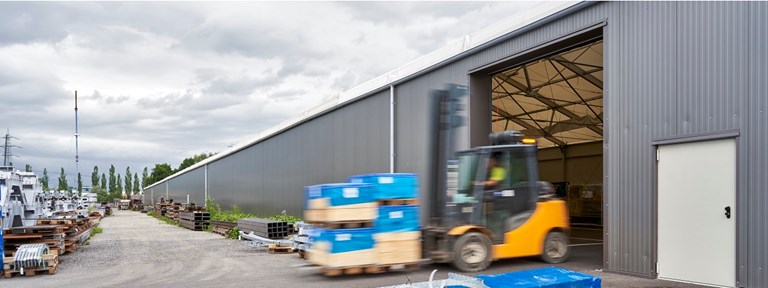Nothing was standard on this 250 m long warehouse project
Constructing a warehouse sounds like a run-of-the-mill job for us, right? Well, not if you know that this warehouse is 250 meters long, is situated in an area with heavy snowfall, and that this is, in fact, an extension to a warehouse we built three years ago.
We discuss this project for ropeway, cable-cars and ski lift experts Doppelmayr from Austria with our project manager Lars Karl, who specializes in halls and large-scale industrial buildings.
This warehouse is special in many ways. Among other things, because it wasn’t built in one go, was it?
“That's right. We built the first part of the warehouse complex, which is 152 m long in total, three years ago on the premises of Doppelmayr Seilbahnen GmbH. When the original hall had reached its capacity limits, we added a 100-metre extension in the spring of 2021.”
A 20 m wide and 5.20 m high Induflex industrial hall was used. Why did Doppelmayr opt for this type of hall?
“The Induflex is our most flexible industrial hall, and offers several advantages that came into play in this project. For example, it can be equipped with various roof and wall coverings and is very robust and wind- and snow load resistant thanks to its Eurocode-compliant construction. These properties were particularly important with regard to the location in Wolfurt, Austria, where heavy snowfall is common.”
What special requirements where there?
“First and foremost, it had to be fully insulated so that temperature-sensitive goods and merchandise could also be stored. For this purpose, we equipped our Induflex with a customized roof in combination with sandwich walls. In addition, it had to withstand high snow loads of 215 kg on the ground and 172 kg in the roof. To make this possible, we shortened the truss spacing from 5 to 4 m and added a truss in the eaves. So, we customized several components to offer the best possible solution.”
Why does weight play such an important role?
“Static specifications are decisive when it comes to hall planning. We take everything into account, to ensure that we can deliver a building that is not only Eurocode-compliant, but that can also withstand the more extreme wind and snow loads that are needed in this specific area. These calculations determine everything, from the frame we choose to the anchoring. The heavier the load on the roof, the stronger the frame construction and the profile have to be. But, a larger profile is also an important factor in the costs, so that is something the client has to consider. We want to be transparent and clear on costs as well as on all possible options, so that the client can make the right decision.”
What was the biggest challenge in this project?
“The biggest challenge was all the custom work we had to do to the roof, to make sure that we could deliver exactly what the client needed while still making the construction strong enough to handle the climate. But with the right equipment and some creative thinking, we were able to pull it off.”
In the end, you delivered the building turnkey. What do you mean by that?
“If a building is handed over turnkey, the customer can use it immediately. Various preparations are necessary for this, which we are happy to take care of. For Doppelmayr, we took over all the essential project steps, from the statics to the equipment to the complete assembly of the hall. This included the static calculations for the extension, the production and purchasing of all parts and components such as roller doors, skylight domes or heaters, as well as the coordination of material and personnel on site in order to complete the hall on time and within budget.”
